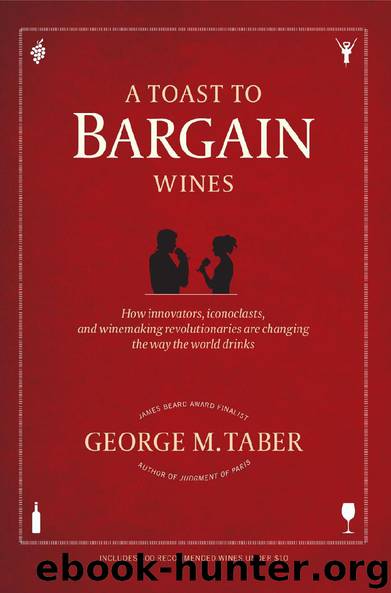A Toast To Bargain Wines by George M. Taber

Author:George M. Taber
Language: eng
Format: epub
Publisher: Scribner
John Casella’s goal when [yellow tail] hit the American market was to get 10 percent of Rosemount’s American sales, at that time about 1.5 million cases annually. “I thought if we could sell a hundred fifty thousand to two hundred thousand cases, I’d be happy,” he recalls. He believed he had a chance because Rosemount was selling at a price then about 50 percent higher, and its popularity had been sliding even before its April 2001 merger with Southcorp, another giant winery. With little more than the right product and word-of-mouth promotion, [yellow tail] hit Casella’s dream goal within six months. Wine Business Monthly, which closely tracks sales trends, soon reported that consumers were marching into wine stores and requesting “that wine with the yellow color” or “the wine with the kangaroo.” The wine was available only under allocations for the first three years, and the first traditional advertising campaign in the United States did not appear until 2004.
After anxiously worrying about the success of a new brand and the future of his company if [yellow tail] failed as Carramar had, John now faced another set of problems that could just as easily have tanked his family business. Overnight success is a nightmare for a small company, which often cannot keep up with demand. The first thing that usually happens is that product quality collapses, as the business increases production too fast and lowers standards. The second is that the company raises prices, and customers revolt. The third is that the company hires people too fast, and often the wrong people. Many high-flying companies have crashed and burned on the tarmac of success.
John Casella was facing exactly those issues by late 2001. The bottling line, which was running two days when sale started, began running seven days a week. The company introduced two shifts a day, then three. Finally a massive second bottling line was installed. At one point, the whole of Australia had run out of magnum bottles, and Casella faced the loss of those attractive sales. He had to air-freight bottles from Italy to continue production. Could the company keep up with the almost insatiable demand from American consumers? It was a nice problem to have, but still a major challenge.
In the second half of 2001, the first seven months on the market, sales were 399,000 cases. In 2002, they reached 2.2 million. The following year the company hit 4.7 million, in 2004 6.5 million, and in 2005 8 million. During that spectacular growth, many Australian and American wineries off on the sidelines were saying that [yellow tail] would never last. It was going to be just another American fad, similar to earlier booms in Lambrusco and wine coolers.
One of the first steps Deutsch and Casella took was to control the rollout across the United States. Instead of trying to supply the whole country with the suddenly popular wine and running out in some markets, they introduced it state by state. The last state to get [yellow tail] was California.
Download
This site does not store any files on its server. We only index and link to content provided by other sites. Please contact the content providers to delete copyright contents if any and email us, we'll remove relevant links or contents immediately.
101 Whiskies to Try Before You Die by Ian Buxton(44793)
World's Best Whiskies by Dominic Roskrow(44732)
Whiskies Galore by Ian Buxton(41867)
Craft Beer for the Homebrewer by Michael Agnew(18140)
Right Here, Right Now by Georgia Beers(4123)
Not a Diet Book by James Smith(3335)
Water by Ian Miller(3126)
The Coffee Dictionary by Maxwell Colonna-Dashwood(3062)
Kitchen confidential by Anthony Bourdain(3007)
Coffee for One by KJ Fallon(2563)
Smuggler's Cove: Exotic Cocktails, Rum, and the Cult of Tiki by Martin Cate & Rebecca Cate(2469)
Superfood Smoothie Bowls: Delicious, Satisfying, Protein-Packed Blends that Boost Energy and Burn Fat by Chace Daniella(2387)
Talking as Fast as I Can by Lauren Graham(2380)
Beer is proof God loves us by Charles W. Bamforth(2370)
Bourbon: A Savor the South Cookbook by Kathleen Purvis(2244)
A Short History of Drunkenness by Forsyth Mark(2233)
Eat With Intention by Cassandra Bodzak(2154)
Cocktails for the Holidays by Editors of Imbibe magazine(2081)
Colombia Travel Guide by Lonely Planet(2061)
